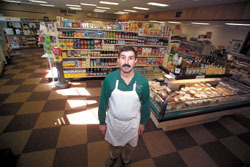
Westerly deli owner, Tony Spino, has has to compete with a nearby Wal-Mart SuperCenter.
Westerly retailers adjust to life with SuperCenter; rest of state takes note
Tony Spino has sold meats at his Westerly grocery store and deli, Dunn’s Corners Market, for about 16 years. Two years ago, the business fell into the shadows of a Wal-Mart SuperCenter, a behemoth store that carries acres of products, including meats and other supermarket items.
Spino didn’t know what to expect when the smaller Wal-Mart morphed into a SuperCenter. So far, the impact has been mixed.
“In the winter, it hurts us because people just want to shop in one place because it’s cold, so they just get everything they need at Wal-Mart,” Spino said. “In the summer, having Wal-Mart there helps us because there is more traffic in the area and people stop in here.”
Spino, and other Westerly business owners, say the key to surviving is playing to their strengths and creating niches not covered by Wal-Mart.
Spino and other Westerly businesses might serve as a case study of how Wal-Mart’s rapidly expanding SuperCenter brand impacts smaller businesses.
At least two area communities should take particular notice: Johnston and Woonsocket have SuperCenters in the works.
The Johnston project is planned for vacant land surrounded by Route 6, Interstates 195 and 295, and Atwood Avenue. The project, which includes a Sam’s Club, also owned by Wal-Mart, is under the development of Johnston-based Carpionato Properties. If all goes as scheduled, the store will open in 2006.
In Woonsocket, the city council approved a zoning change for Wal-Mart, allowing it to buy and develop six acres of city land to expand an existing store on Diamond Hill Road. Woonsocket residents abutting the proposed SuperCenter are challenging the expansion in court, a town official said.
Nationally, there appears to be no stopping Wal-Mart, which plans to open approximately 240 to 250 new SuperCenters in this fiscal year. The mega-stores are in fact outpacing traditional Wal-Mart stores: 1,713 to 1,353.
The growth of these SuperCenters has one local lawmaker working to curb such projects. State Rep. Thomas Slater, a Providence Democrat, introduced a bill designed to protect grocery stores by limiting the size of any retailer selling perishable items to 100,000 square feet. It’s the third straight year a bill targeting the SuperCenters has been introduced.
Local United Food and Commercial Workers 328 is backing Slater’s legislation. Richard McAuliffe, chairman of the Providence-based Mayforth Group, which lobbies for the union, said Wal-Mart is able to sell products at low prices because of relatively low wages and inferior health benefits it offers employees compared to supermarkets with unions.
“There has been a Wal-Mart SuperCenter tide around the country that is hurting grocery stores like Shaw’s and Eastside Marketplace in Providence and Stop & Shop, one of the state’s biggest employers,” said McAuliffe.
Legal and planning experts say bills like Slater’s have their legal challenges because they are so specific – singling out retailers selling perishables.
“Buildings are normally restricted on the way they look or their size depending on the neighborhood,” said Providence City Planner Christopher Ise. “I’ve never seen this sort of restriction, it’s sort of an odd way to keep Wal-Mart from building SuperCenters.”
Ise’s department has been handling a proposed Wal-Mart – not a SuperCenter – on Silver Spring Avenue, where a vacant Ames Shopping Plaza stands.
Wal-Mart is used to local roadblocks.
“We deal with opposition all the time. It’s just something you expect as the world’s largest retailer,” said Wal-Mart spokesperson Rhoda Washington.
Responding to the company’s pay and benefits, Washington said Wal-Mart pays about twice the national minimum wage and increases it based on cost of living in each state. Also, the company offers part- and full-time employees benefits.
The extent of the SuperCenter’s reach into a slew of retail markets can be seen in the Woonsocket proposal. The 24-hour store will carry all of the things traditional Wal-Mart stores have, plus pharmaceuticals, optical, and a full line of grocery items including meat, produce, deli and bakery. The SuperCenters also have Tire and Lube Expresses, McDonald’s or Subway restaurants, portrait studios and one-hour photo centers, hair salons, banks and employment agencies.
Like thousands of small-business owners across the country, staying afloat while competing with the SuperCenters is a matter of adjusting. Spino and other small businesses that compete with the SuperCenter in Westerly do so by differentiating themselves, usually with better service and unique or higher quality products, said Spino.
“Wal-Mart doesn’t come close to us in the freshness department,” Spino said.
Stephen Cersosimo owns Granite One Hour Photo on Granite Street in Westerly, about five miles from the SuperCenter. Fortunately for him, Granite One is more than photo-developing, so he’s been able to offset some of the revenue he lost to Wal-Mart’s photo center.
Now he does more custom framing, digital photo restorations and enlargements, even though the prices for film development, $8.99 for 24 doubles, aren’t much more than at Wal-Mart.
“When Wal-Mart came in, I knew it would hurt us. People like the convenience of dropping off their film while shopping,” he said.
Lisa Konicki, president of the Westerly-Pawcatuck Chamber of Commerce, said there is a clear upside to the SuperCenter, including the people it draws to the area.
“At first, there was concern from grocery stores and small photo developers, but here we are today and none of them have closed,” Konicki said. “When a Wal-Mart comes into a town, small businesses re-evaluate the products they sell and the services they provide. They end up selling higher quality and provide the service to back it up.”












